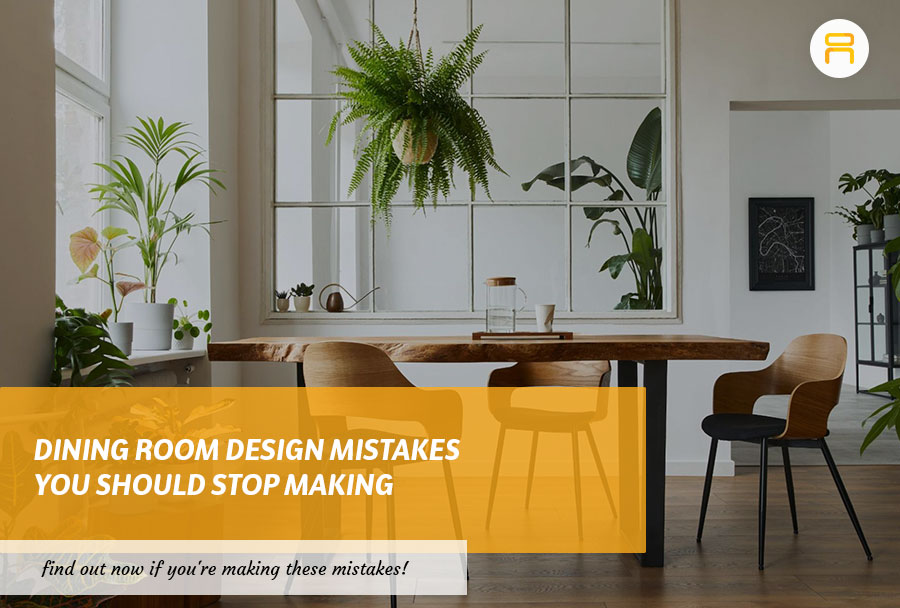
8 Dining Room Design Mistakes You Should Stop Making
Your dining room is a hub of activity in your home. It’s where you gather with family and friends to share meals, celebrate special occasions, and create lasting memories. However, if your dining room design isn’t up to par, it can detract from the overall atmosphere and functionality of the space. In this article, we’ll highlight some common dining room design mistakes and offer practical tips on how to avoid them.
Related: 7 Must-Know Tips To Style Your Dining Room
What’s Inside
- Oversized Furniture Overload
- Poor Lighting Choices
- Texture and Layering Lapses
- Lack of Personal Touches
- Ignoring Functionality
- Cluttered Tabletops
- Tall Centerpiece Troubles
- Neglecting the Rug Situation
Mistake #1: Oversized Furniture Overload
The Problem: One of the most common mistakes people make when designing their dining room is choosing furniture that’s too large for the space. Oversized dining tables, chairs, and sideboards can make the room feel cramped and unwelcoming.
Related: Common Mistakes When Buying A Furniture
The Fix: Before purchasing furniture for your dining room, see to it that you measure the space carefully and consider the scale of the room. Opt for furniture that fits comfortably within the room’s dimensions, leaving enough space for people to move around freely. Consider round or oval tables, which can be more space-efficient than rectangular ones in smaller rooms.
Related: How To Know The Right Dining Table Shape That Will Fit Your Home
Mistake #2: Poor Lighting Choices
The Problem: Inadequate or poorly chosen lighting can significantly impact the ambiance of your dining room. Harsh overhead lighting or dim, insufficient lighting can make it difficult to create the right mood for dining and entertaining.
The Fix: Aim for a layered lighting approach in your dining room, combining overhead fixtures with task lighting and accent lighting. Consider installing a dimmer switch to control the brightness level and create the desired atmosphere for different occasions. Pendant lights or chandeliers can add a touch of elegance and provide focused illumination over the dining table.
Mistake #3: Texture and Layering Lapses
The Problem: Overlooking texture and layering in your dining room design can result in a space that feels flat and uninspired. Without a variety of textures and layers, your dining room may lack visual interest and depth, leading to a less inviting atmosphere.
The Fix: Incorporate texture and layering into your dining room design to create a more dynamic and visually appealing space. You can also try to experiment with different materials such as wood, metal, glass, and fabric to add depth and dimension to the room. Mix and match textures by combining smooth surfaces with rough, tactile elements to create contrast and visual intrigue. For added texture and design, layering textiles like tablecloths, placemats, and napkins can add warmth and softness to the dining table.
Mistake #4: Lack of Personal Touches
The Problem: Another common mistake in dining room design is overlooking the opportunity to add personal touches and character to the space. A generic, cookie-cutter dining room lacks personality and fails to reflect the unique style and preferences of its inhabitants.
The Fix: Infuse your dining room with personality by incorporating personal mementos, artwork, and decorative accents that resonate with you and your family. Whether it’s a gallery wall of family photos, a collection of vintage china, or a statement piece of artwork, adding personal touches will make your dining room feel more inviting and authentic.
Mistake #5: Ignoring Functionality
The Problem: While aesthetics are important in dining room design, of course it’s crucial not to overlook functionality. A beautiful dining room won’t serve its purpose if it’s not practical and comfortable for everyday use.
The Fix: Consider how you use your dining room on a daily basis and prioritize functionality when designing the space. Choose furniture that’s comfortable and durable, with easy-to-clean materials that can withstand spills and stains. Make sure there’s enough seating for your family and guests, and arrange the furniture in a way that promotes conversation and interaction during meals.
Mistake #6: Cluttered Tabletops
The Problem: A cluttered dining table can detract from the overall look and feel of your dining room, making it feel chaotic and disorganized. Piles of mail, random knick-knacks, and unnecessary clutter can overwhelm the space and make it difficult to enjoy meals.
The Fix: Keep your dining table clear of clutter by designating a specific spot for mail and other items that tend to accumulate. Invest in stylish storage solutions like decorative baskets or trays to corral clutter and keep the tabletop tidy. Reserve the dining table for mealtime essentials like place settings, centerpieces, and serving dishes to create a clean, inviting space for dining and entertaining.
Mistake #7: Tall Centerpiece Troubles
The Problem: While a centerpiece can add visual interest and serve as a focal point in your dining room, opting for a tall centerpiece can sometimes do more harm than good. Tall centerpieces can obstruct sightlines, making it difficult for guests to see and interact with each other across the table.
The Fix: Instead of choosing a tall centerpiece that blocks conversation, opt for low-profile alternatives that still make a statement without obstructing views. You can consider using a cluster of smaller vases or bowls filled with fresh flowers or greenery to add color and texture to the table without overwhelming the space. If you prefer a taller centerpiece, see to it that it’s narrow enough to allow for easy conversation and doesn’t impede the line of sight across the table. Keep in mind that it’s important to strike a balance between aesthetics and functionality to create a dining room centerpiece that enhances rather than detracts from the overall dining experience.
Mistake #8: Neglecting the Rug Situation
The Problem: Many people neglect the importance of rugs in their dining room design. A well-chosen rug can tie the room together and add warmth and texture to the space. However, using the wrong size or style of rug can throw off the balance of the room.
The Fix: When selecting a rug for your dining room, choose one that’s large enough to accommodate the dining table and chairs, even when they’re pulled out. Ideally, the rug should extend beyond the edges of the table to create a cohesive look. You can go for a durable, easy-to-clean rug material like wool or synthetic fibers to withstand spills and foot traffic.
By avoiding these common dining room design mistakes, you can create a welcoming and functional space that’s perfect for gathering with loved ones and enjoying good food and company. With careful planning and attention to detail, you can design a dining room that reflects your personal style and improves your everyday living experience.
If you are looking for dining room furniture in Metro Manila, visit our page. We have a variety of furniture items for you to choose from!
Like our Facebook page and follow us on our Instagram to keep in touch with us regularly.



